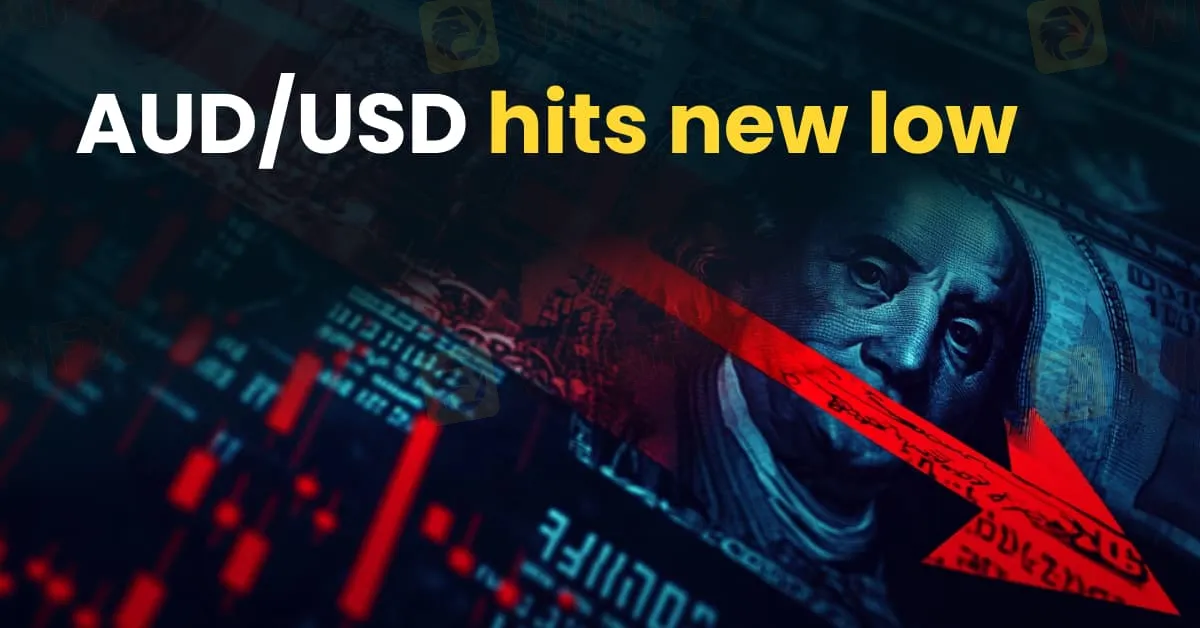简体中文
繁體中文
English
Pусский
日本語
ภาษาไทย
Tiếng Việt
Bahasa Indonesia
Español
हिन्दी
Filippiiniläinen
Français
Deutsch
Português
Türkçe
한국어
العربية
AUD/USD Hits New Lows as Panic Selling Unfolds Amid Robust U.S. Jobs Report
Abstract:The Australian dollar tumbled to a fresh multi-year low of 0.5932 against the U.S. dollar, breaking through several key technical support levels and triggering widespread panic selling in the currency markets. The sharp decline comes at a time when mixed signals from economic data and monetary policy expectations are creating a volatile environment for traders and investors alike.

The Australian dollar tumbled to a fresh multi-year low of 0.5932 against the U.S. dollar, breaking through several key technical support levels and triggering widespread panic selling in the currency markets. The sharp decline comes at a time when mixed signals from economic data and monetary policy expectations are creating a volatile environment for traders and investors alike.
Technical Breakdown Sparks Market Sell-Off
The AUD/USD pairs plunge below 0.5932 marks the lowest level in recent years, as the Australian dollar succumbed to selling pressure on multiple fronts. Technical analysts noted that the pair breached several important support levels, prompting a cascade of stop-loss orders and panic selling. Market participants reacted swiftly, with many traders rushing to exit positions as risk aversion took hold. The breakdown has further exacerbated concerns that the underlying momentum could force the currency lower if investor sentiment fails to stabilize.
Strong U.S. Jobs Data Raises Mixed Signals
Adding to the complex economic landscape, the latest U.S. Labor Department data revealed that nonfarm payrolls surged by 228,000 in March—significantly outperforming Februarys revised gain of 117,000. This robust job creation suggests that the U.S. labor market remains strong despite ongoing global economic uncertainties. However, the report also showed that the unemployment rate ticked up slightly to 4.2% from 4.1%, surpassing market expectations and hinting at potential headwinds for the U.S. economy.
Fed Rate-Cut Expectations Remain Intact
Despite the encouraging employment numbers, market sentiment appears to be focused on the prospect of further monetary easing. Investors have already priced in a total of 100 basis points of Fed rate cuts over the course of the year, and some analysts do not rule out the possibility of an additional (fifth) rate cut. The expectation of lower borrowing costs is seen as a counterbalance to the strong jobs data, reinforcing the belief that accommodative monetary policy will prevail in the coming months.
Implications for Investors
For investors, the confluence of a sharply weakening Australian dollar and strong U.S. labor market data creates a paradox. On one hand, the robust U.S. jobs report supports the economic fundamentals of the dollar, while on the other, a deteriorating AUD/USD technical picture suggests that risk-off sentiment remains prevalent in global currency markets.
A weaker Australian dollar could benefit export-oriented Australian companies by making their goods more competitive overseas. Conversely, for Australian consumers and businesses that rely on imported products, the lower exchange rate could lead to higher costs and increased inflationary pressures. Moreover, if the Fed continues its course of rate cuts amid persistent economic uncertainty, further depreciation of risk-sensitive currencies like the Aussie might be on the horizon.
Looking Ahead
Analysts advise that traders and investors closely monitor upcoming economic indicators, including inflation readings and central bank commentary, to gauge the trajectory of both the U.S. economy and the AUD/USD pair. With technical weaknesses now clearly evident and monetary policy expectations still leaning toward further easing, market volatility is likely to persist in the near term.
In summary, while the U.S. labor markets resilience provides a positive backdrop for the dollar, the pronounced technical breakdown in the AUD/USD pair underscores the challenges facing the Australian currency. Investors are left balancing between the strong fundamentals of the U.S. economy and the caution warranted by a risk-off environment in global currency markets.

Disclaimer:
The views in this article only represent the author's personal views, and do not constitute investment advice on this platform. This platform does not guarantee the accuracy, completeness and timeliness of the information in the article, and will not be liable for any loss caused by the use of or reliance on the information in the article.
Read more

How to protect your money during Black Monday
Black Monday—the day when markets crashed and panic selling took over—reminds us that economic downturns are part of the investing cycle. While such days can trigger fear and uncertainty, being prepared with a well-planned strategy can help protect your hard-earned money. In this article, we’ll explore actionable tips on safeguarding your investments and overall finances during a market crash.

Shocking! Oil Prices Plunge Below $60
Oil prices are in free fall. On April 7, the market extended its slide — WTI crude dropped below $60 per barrel, while Brent crude fell to $63, hitting a four-year low.

Gold Prices Plunge: How Should Investors Respond?
Is Gold No Longer a Safe Haven? Prices Plunge and Investors Panic!

The Impact of Interest Rate Decisions on the Forex Market
Interest rate changes determine currency attractiveness, influencing capital flows and exchange rate trends. Understanding this mechanism helps investors navigate the forex market effectively.
WikiFX Broker
Latest News
INFINOX Partners with Acelerador Racing for Porsche Cup Brazil 2025
Global Panic Builds as Forex Shifts into Risk-Off Mode
Shocking! Oil Prices Plunge Below $60
BI Alerts Filipinos: Telegram, Facebook Used for Trafficking Scams
AUD/USD Hits New Lows as Panic Selling Unfolds Amid Robust U.S. Jobs Report
SEC Fines Velox Clearing $500,000 for SAR Failures
How to protect your money during Black Monday
FCA Released New List of Unauthorized Brokers
Singapore Authorities Warned Against WeChat, UnionPay, Alipay Impersonation Scams
Deepfake Scams Nearly Drain $499K from Business
Currency Calculator







